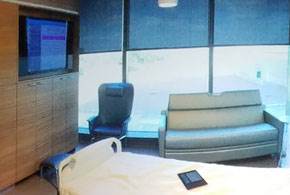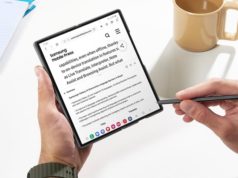A new hospital being built at UC-San Diego has iPads and Apple TV in each of its 245 rooms to empower patients in their own medical care.
MINNEAPOLIS—When patients are admitted to hospitals today, they typically have a white board mounted in their rooms where caregivers list their names, medicines and medical notes to help guide the care of the patient.
But at the newly built Jacobs Medical Center in San Diego, white boards have given way to Apple iPads and Apple TV in each room, where patients will be able to log in once they are admitted. Using the iPads, patients will be able to access deeper details about their caregivers, in-room controls for lighting, window shades and room temperature, as well as peruse their personal medical records and details about their treatments and upcoming procedures. Using Apple TV, patients will have access to entertainment and streamed video, as well as maintaining connections with friends and family using social media and video including FaceTime and Skype.
“We’re giving patients visibility into why they are there,” Eric Boyd, a member of the infrastructure workstation management team at the University of California-San Diego Health unit, which owns and operates the new facility, told eWEEK at the Jamf Nation User Conference held here Oct. 18 to 20. “We’re reducing the worries of being in a hospital and empowering patients” to have quick and easy access to what is happening to them as part of their treatment.
While the new hospital has not yet opened, 25 iPads and an accompanying MyChart Bedside app from software vendor Epic have been piloted at another UCSD hospital in the last six months and have shown great results, said Boyd.
Originally, the first tablet pilot project was started a year ago with 25 Android devices because they were cheaper to buy. The move was quickly made to Apple devices, though, when administrators learned that it was harder to find reliable ways of wiping the Android devices clean of personal patient data each time someone was admitted or discharged from the hospital. The Android tablets required hands-on visits from IT workers to delete personal information, making the process entirely too unwieldy and labor-intensive, said Marc Sylwestrzak, director of IS experience and development at UCSD Health.
At the same time, Epic finally released an iOS version of its MyChart Bedside app earlier in 2016, so iPads could then be considered for use in Jacobs Medical Center, he said.
“We wanted a [product] without having to go in and manually wipe data without touching them” with human hands, said Sylwestrzak. Also key needs were ultra-high security for patient information and the ability to allow patients to add their own apps to the devices while they are staying in the hospital to help them control their own lives.
To do that, UCSD Health is using Jamf’s Casper Suite, which has just been renamed Jamf Pro, to administer all of the iPads using dashboards and controls from afar. Jamf Pro is being tested on the devices now and ultimately will let UCSD Health IT administrators automatically and remotely wipe the devices when a patient is discharged to get it ready for the next user in the hospital room, according to Sylwestrzak.
Jamf Pro works with the Epic app to coordinate iPad management with patient records, ensuring that Health Insurance Portability and Accountability Act (HIPAA) privacy requirements are protected at all times.
The iPads and the MyChart Bedside apps also allow patients and their families to put video games on the iPads to entertain children who are visiting patients, giving the children something to do while in the hospital. That’s been very helpful so far, said Boyd.
“We’ve seen measurable results—nurses say that families are staying longer when they visit, which is really beneficial for the patients,” he said. “The goal was to make things easy for the patients, to make them feel more secure.”







